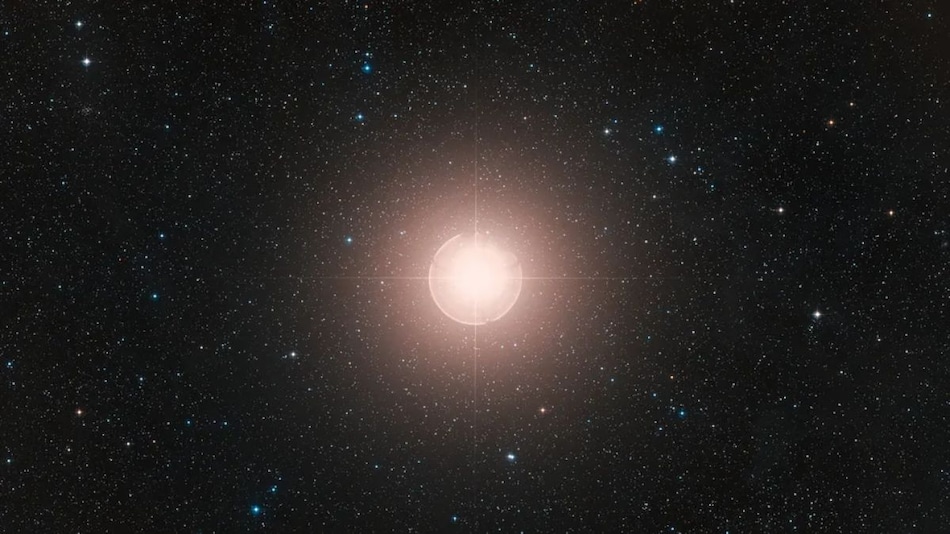- Home
- Science
- Science News
- NASA Telescopes Capture First Ever Companion Star Orbiting Massive Red Supergiant Betelgeuse
NASA Telescopes Capture First-Ever Companion Star Orbiting Massive Red Supergiant Betelgeuse
Scientists discover a small companion star orbiting Betelgeuse, reshaping binary star theories.

Photo Credit: NASA
NASA’s telescopes reveal a small companion star orbiting the red supergiant Betelgeuse
Astronomers have successfully seen the companion star of a type of supernova and thus proved its approach was responsible for this kind of exigent explosion. The faint companion is seen at its maximum distance from Betelgeuse thanks to NASA's Chandra X-ray Observatory and the Hubble Space Telescope—observations made by a team of researchers from Carnegie Mellon University (CMU). It represents the first confirmed sighting of a companion star orbiting such an enormous and evolved celestial behemoth—one that is more than 700 times as large as our Sun and thousands of times brighter.
Discovery of Betelgeuse's Tiny Companion Challenges Theories of Binary Star Formation
As per a report published in The Astrophysical Journal on October 10, the finding was made after the Gemini North Telescope in Hawaii captured a faint image near Betelgeuse. Researchers had long suspected a companion due to the star's periodic dimming, but it had never been observed directly. Anna O'Grady, a postdoctoral fellow at CMU, stated that this represents the deepest X-ray observation of Betelgeuse to date, as the companion had always remained hidden behind the bright glare of the giant star.
Prior to their observations, it was expected that Betelbuddy could be a white dwarf or a neutron star, but the absence of known accretion signatures eliminated both cases. Now, researchers think the companion could be a nascent sun-like star, a class of “extreme mass ratio binaries”. Moreover, 16-17 times more massive than the Sun, believed to be Betelgeuse. It means that this star couple is highly lopsided.
Researchers discovered binary systems with stars of similar masses, potentially reshaping theories on massive star evolution. Betelgeuse's proximity enabled the discovery, despite rare observational challenges.
The study suggests that future observations with next-generation telescopes could help understand the influence of Betelbuddy on Betelgeuse's evolution and its potential supernova fate.
Get your daily dose of tech news, reviews, and insights, in under 80 characters on Gadgets 360 Turbo. Connect with fellow tech lovers on our Forum. Follow us on X, Facebook, WhatsApp, Threads and Google News for instant updates. Catch all the action on our YouTube channel.
Related Stories
- Samsung Galaxy Unpacked 2025
- ChatGPT
- Redmi Note 14 Pro+
- iPhone 16
- Apple Vision Pro
- Oneplus 12
- OnePlus Nord CE 3 Lite 5G
- iPhone 13
- Xiaomi 14 Pro
- Oppo Find N3
- Tecno Spark Go (2023)
- Realme V30
- Best Phones Under 25000
- Samsung Galaxy S24 Series
- Cryptocurrency
- iQoo 12
- Samsung Galaxy S24 Ultra
- Giottus
- Samsung Galaxy Z Flip 5
- Apple 'Scary Fast'
- Housefull 5
- GoPro Hero 12 Black Review
- Invincible Season 2
- JioGlass
- HD Ready TV
- Laptop Under 50000
- Smartwatch Under 10000
- Latest Mobile Phones
- Compare Phones
- Lava Play Max
- Poco C85 5G
- Honor Magic 8 Lite
- Jolla Phone
- Realme P4x 5G
- OnePlus Ace 6T
- Nubia Flip 3
- Nubia Fold
- Asus ProArt P16
- MacBook Pro 14-inch (M5, 2025)
- OnePlus Pad Go 2
- Poco Pad M1
- Just Corseca Skywatch Pro
- Honor Watch X5
- Acerpure Nitro Z Series 100-inch QLED TV
- Samsung 43 Inch LED Ultra HD (4K) Smart TV (UA43UE81AFULXL)
- Asus ROG Ally
- Nintendo Switch Lite
- Haier 1.6 Ton 5 Star Inverter Split AC (HSU19G-MZAID5BN-INV)
- Haier 1.6 Ton 5 Star Inverter Split AC (HSU19G-MZAIM5BN-INV)

















